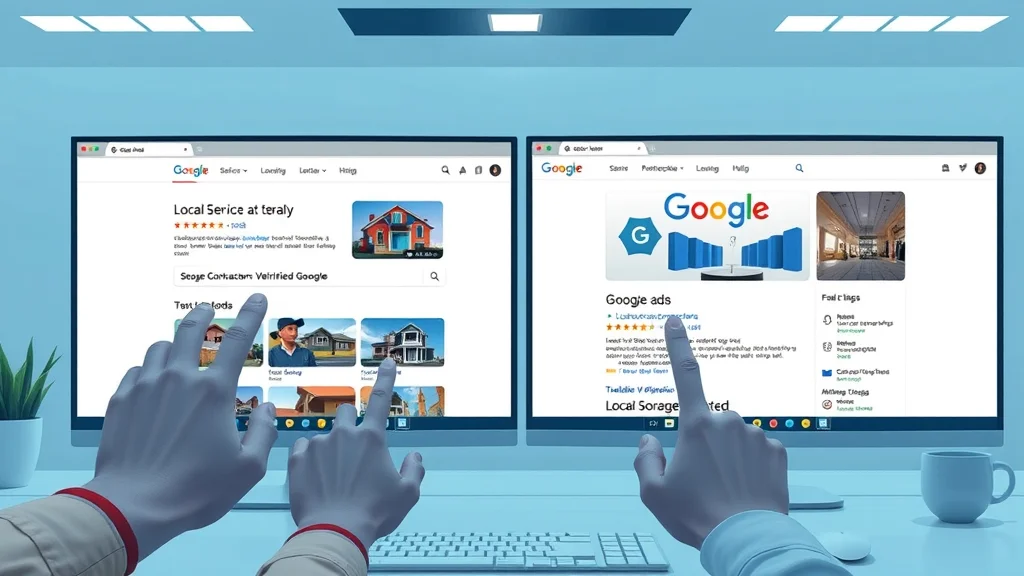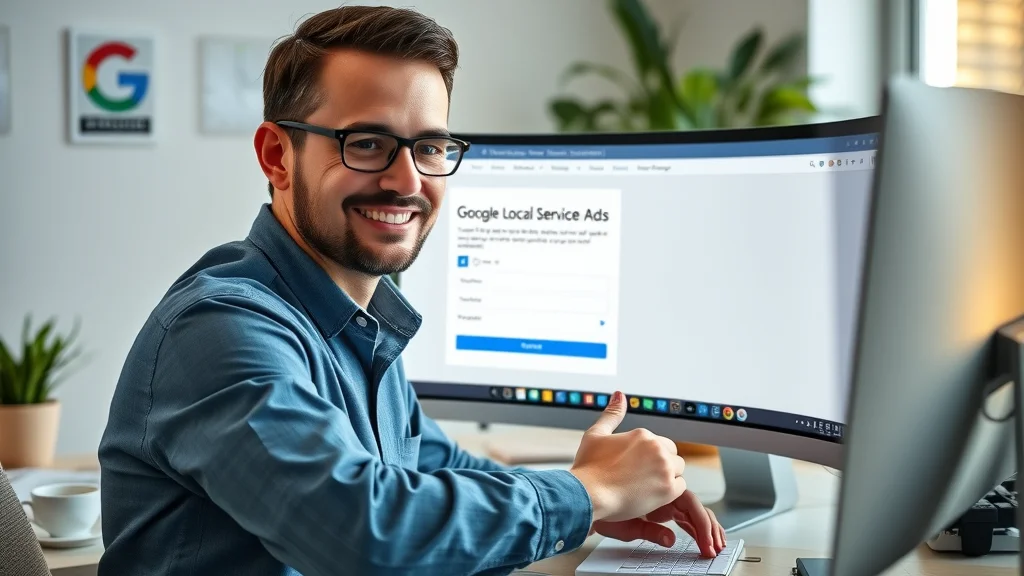Did you know? Contractors see up to 50% more qualified leads with Google Local Services Ads, yet less than 30% leverage their full potential. This eye-opening fact reveals a major opportunity for contractors looking to outperform their local competition by connecting with genuine, ready-to-hire customers online. In this article, we’ll cut through the hype and show you how Google Local Services Ads can move the needle for your contracting business—helping you dominate local search results, lower your acquisition costs, and build unshakable trust through Google’s stamp of approval.
Unlocking the Power of Google Local Services Ads: An Eye-Opening Look for Contractors
The surge in digital marketing for contractors has made visibility on Google more crucial than ever. Local service providers are competing not just on quality, but on the ability to connect swiftly and authentically with local customers searching for immediate solutions. Google Local Services Ads (often called service ads or LSAs) offer a direct answer to this challenge, appearing at the very top of Google search when potential customers are ready to book a job. Unlike traditional Google Ads, which require click-throughs and complex bidding, LSAs put your business front-and-center, complete with the coveted Google Guarantee that instills confidence and encourages quick action. For contractors, this means more qualified leads, lower acquisition costs, and potentially game-changing results.
As a contractor, the question isn’t just “Should I advertise online?”—it’s “How do I advertise smarter?” With Google Local Services Ads, you’re not simply reaching more eyes; you’re connecting with local customers in your exact service area at the moment they need you most. If you’ve ever wrestled with lead quality, wasted ad spend, or standing out among crowded listings, keep reading—because what follows could reshape your marketing strategy for good.

"Contractors see up to 50% more qualified leads with Google Local Services Ads. Yet, less than 30% are leveraging its full potential." — Digital Marketing Institute
What You'll Learn About Google Local Services Ads
- What Google Local Services Ads are and how they work for contractors
- Key features: Local service, local services ad, Google guarantee, and more
- How Google Local Services Ads differ from traditional Google Ads
- Cost, value, and typical ROI of service ads for contractors
- Actionable steps to get started and optimize your campaign
What Are Google Local Services Ads?
Defining Google Local Services Ads for Contractors
Google Local Services Ads are a pay-per-lead advertising platform tailored specifically for local businesses such as contractors, home services providers, and other service-based professionals. Unlike traditional google ads that operate on a pay-per-click basis, local service ads place your business at the top of google local search results when potential customers in your service area look for your expertise.
To qualify, contractors create a detailed business profile including their services, service area, and professional credentials. The ads showcase your star rating, the Google Guarantee badge, business hours, and links for new customers to call or message you directly. With a focus on jobs and gain for the community’s best talent, these ads spotlight your business when homeowners and organizations need skilled contractors in real time, instilling confidence for first-time customers through Google's verification process.

How Contractors Benefit from Local Services Ads
The advantages go beyond mere visibility: Google Local Services Ads offer contractors the opportunity to connect with motivated local customers at the exact moment they are searching for your services. This isn’t just about more leads—it’s about better ones. The ads are designed to display only for users within your defined service area, prioritizing relevance. The Google Guarantee badge acts as a trust signal, giving homeowners the peace of mind to confidently reach out for urgent repairs, remodels, or installations.
Higher lead quality means less time spent filtering unsuitable inquiries or following up with unqualified prospects. And because you only pay when a genuine prospect contacts you, local services ads usually offer a lower cost per acquisition than most other digital channels. The result? More jobs booked, better reviews added to your Google business profile, and a reputation that grows with every satisfied customer.
"Local services ads are unique because they directly connect you with local customers searching for your services right now."
How Do Google Local Services Ads Work?
Local Service Ad Placement vs Traditional Google Ads
Unlike Google Ads, which charge per click and appear below the local map pack or organic listings, local service ads appear at the very top of the results page—often above even paid search and map packs. When local customers search for terms like “plumber near me” or “HVAC repair in [city],” these ads are the first offering they see, complete with star ratings, hours, and the prominent google guarantee or google screened badge. This placement ensures you get seen by customers before they scroll past or get distracted by competitors.
Another key distinction: instead of paying every time someone merely clicks your ad, you pay only when a lead contacts you directly—making service ads highly cost-effective. For contractors, this approach dramatically reduces wasted spend and focuses every dollar on leads most likely to convert. As a result, your jobs and gains from local search traffic can increase measurably, and reputation grows faster in the communities you serve.

The Google Guarantee and Google Screened Badges Explained
A critical advantage of Google Local Services Ads is trust. The Google Guarantee badge shows customers your business is vetted by Google, with background checks, license verification, and ongoing compliance. This badge not only increases click rates but also instills immediate trust—if customers are dissatisfied with your work, Google may refund them (up to a lifetime maximum).
In select categories, contractors may also earn a Google Screened badge, which similarly demonstrates passing background checks, reviews, and insurance checks. The presence of either badge often tips the scale in your favor, giving you a significant edge over businesses with no such verification. When local customers see these badges, they know they are dealing with reputable, local professionals who have been thoroughly vetted.
Getting Your Business Profile Google Guaranteed
The process for getting your contracting business Google Guaranteed starts with completing your business profile on the Local Services Ads platform. You’ll need to provide documentation such as licenses, insurance, and background checks for yourself and any field staff. Once submitted and verified, the Google Guarantee badge will be displayed on all your service ads, helping you stand out in local search results.
While the process can take a week or more depending on documentation, it’s a one-time investment that continues to pay dividends with higher conversion rates and customer trust. A well-maintained Google business profile—regularly updated with new reviews and accurate service hours—ensures you remain eligible for the badge and keep winning new jobs.
Are Google Local Services Ads Worth It?
"Contractors report a 27% lower cost per acquisition using service ads than other online channels."
Local Customers: Higher Quality Leads with Local Service Ads
When contractors use local service ads, they’re tapping into a high-intent audience: homeowners or businesses already searching for a provider in your specialty and area. These aren’t generic leads; they’re potential customers who are ready to hire—local customers in your community. Built-in screening and easy access to your google business profile and customer reviews further encourage quality leads to engage, reducing time wasted on tire kickers or price shoppers.
Here’s the real value: Studies show 27% better cost per acquisition and up to 50% more closed jobs compared to traditional digital ads. By putting your services ad directly in front of someone who needs “a reliable contractor near me,” Google Local Services Ads shift the odds dramatically in your favor. Local search is now the front door to your business—make sure you’re standing right behind it.

Results: Real Contractor Experiences with Local Services Ads
Contractors nationwide report measurable gains after switching to local services ads. From roofers in Denver to electricians in Dallas, real-world users consistently cite higher lead quality, more frequent phone calls from qualified local customers, and a visible boost in online reputation. Many note a major reduction in cost per lead—as well as fewer no-shows or non-serious inquiries.
One contractor shared, “We once relied on third-party lead sites where we competed for every job and wasted hours cold-calling. With Google Local Services Ads, our phone rings with people who are ready to book. It’s night and day.” For businesses committed to serving customers in the communities they know best, LSAs are a clear choice for maximizing return on marketing investment.
How Much Do Google Local Services Ads Cost?
Understanding the Pay-Per-Lead Pricing Model
Google Local Services Ads use a pay-per-lead model, charging you only when a potential customer directly contacts your business through the ad (via message or phone call). There’s no guesswork with impressions or wasted spend on clicks that don’t convert—every dollar is aimed at acquiring real, interested leads in your specific service area. Typical costs range from $15 to $50 per lead, depending on your trade, local competition, and geographic region.
Because you’re only charged for verified leads, google local services ads offer predictable spending and the ability to estimate your budget and return on investment. You can set weekly lead budgets to ensure you never exceed your comfort zone—making LSAs accessible to small and growing contractors as well as established firms.

How Costs Compare to Other Service Ad Options
Compared to other pay-per-click advertising like google ads or industry lead-generation platforms, Local Services Ads typically deliver better value due to their lead verification process and conversion-driven placement. Third-party sites may charge per contact—even if the leads are not genuinely interested—while Google’s model means you only pay for real prospects. Let’s break down the numbers:
A typical contractor using LSAs might generate leads for $25 each, while traditional Google Ads campaigns in competitive markets may run $35–$75 per click (not per lead!), and many third-party providers charge flat fees with less transparency about lead quality.
| Ad Platform | Pricing Model | Average Cost Per Lead | Lead Quality | Placement |
|---|---|---|---|---|
| Google Local Services Ads | Pay-per-lead | $15–$50 | Very High | Top of Google search results |
| Google Ads (Search) | Pay-per-click | $35–$75 per click* | Varies | Below LSAs & local map pack |
| Third-Party Lead Sites | Flat fee or Pay-per-lead | $30–$80 | Varies, often lower | External/varied |
*Note: Not every click is a qualified lead.
Setting Up Google Local Services Ads for Contractors
-
Checklist: Requirements for Google Local Services Ads
- Valid business license and insurance
- Background checks for owners and field staff
- Detailed business profile with service area and hours
- Verified Google account and Google Business Profile
- Active phone line for incoming leads
-
Step-by-Step: Setting Up Your Services Ad and Business Profile
- Sign in to Google Local Services Ads with your Google account
- Create your business profile: add services, areas, availability, and photos
- Submit necessary business documents for review
- Set your weekly budget and bid per lead
- Verify your service area and phone number
- Complete Google Guarantee screening process
- Publish your ad and monitor leads in real-time
-
Verifying Service Area and Google Guarantee Process
- Precisely outline your target cities, ZIPs, or regions—only leads from these zones will trigger charges
- Upload and verify all license, bonding, and insurance documentation as prompted
- Complete the background check via Google’s authorized partner for final approval of your badge

Optimizing Google Local Services Ads for Maximum ROI
Fine-Tuning Your Local Services Ad Account
Success with Google Local Services Ads doesn’t stop at setup. Contractors who thrive are those who routinely review, analyze, and optimize their local service ads. That means reviewing call logs and messages, responding to every inquiry promptly, and adjusting your weekly budget to match seasonal demand. Make sure your service hours and service area are always accurate, so local customers know exactly when and where you’re available.
Testing different service types within your ad platform can further boost performance—focus budgets on your highest-margin categories for maximum impact. If certain services or zip codes deliver more conversions or reviews, use your analytics dashboard to prioritize those. Staying engaged with your account allows you to identify trends, eliminate wasted spend, and ensure that your business is presented in the best possible light every time a potential customer checks Google search.

Improving Business Profile and Responding to Leads
Your Google business profile is an ongoing sales tool—keep it current with detailed service descriptions and up-to-date photos of recent work. Ask each happy customer to leave a review directly through your ad’s interface, and thank them (or address issues) promptly to demonstrate professionalism. Respond to every call, message, or booking request as fast as you can—Google rewards fast responders with higher rankings and increased visibility for local service ads.
Add new services or update your list seasonally, and set clear pricing wherever possible. Accurate business hours and instant responses give confidence to customers to choose your business over competitors, as responsiveness is a key ranking factor within LSAs. Over time, your business profile becomes a living testimonial to your skills and customer care.
Using Customer Reviews to Enhance Your Google Local Service Ranking
Reviews are the lifeblood of high-performing service ads. Google uses the number and quality of reviews to determine which ads display in prime positions. Encourage satisfied clients to leave detailed, positive feedback directly through your LSA interface—this not only improves your conversion rates but also helps boost your ad placements.
Proactively address negative feedback to show prospective customers that you stand behind your work. Regularly update your business profile with new photos and job summaries, which keeps your content fresh and relevant and signals to Google that your business is active. High ratings and responsive service will keep your business ranking above less-engaged competitors.
-
Tips for Getting More Local Customers from Your Local Service Ads
- Respond to leads within minutes, not hours
- Keep your Google business profile updated year-round
- Request reviews from every satisfied customer
- Use professional photos of your work to inspire trust
- Regularly audit your service area and ad spend for efficiency
Comparing Local Services Ads to Google Ads for Contractors
| Feature | Google Local Services Ads | Traditional Google Ads |
|---|---|---|
| Placement | Top of Google search results (above map pack) | Below LSAs & map pack |
| Pricing Model | Pay-per-lead | Pay-per-click |
| Lead Quality | Very high (customers in your area ready to book) | Variable (some high-intent, some clicks only) |
| Badges/Guarantee | Google Guarantee / Google Screened | No badges or guarantee |
| Management | User-friendly, less hands-on optimization needed | Requires regular keyword, bid, and copy management |
| Best For | Home services, contractors, local business providers | Wider range: ecommerce, products, regional/national brands |
Google Local Services Ads vs. Google Ads: Pros and Cons
While both advertising platforms have their place, Google Local Services Ads are more efficient for contractors targeting specific neighborhoods seeking jobs and gain with less hassle. Pros include higher lead quality, simple pay-per-lead pricing, and instant trust via Google Guarantee. However, LSAs may not yet be available in all niches or areas and have less customization than full-featured Google Ads campaigns.
Traditional Google Ads, on the other hand, offer broader keyword targeting and may be more appropriate for complex campaigns, larger service areas, or highly competitive cities. But they require more daily management and may bring in less-qualified leads—since not all searchers are looking to hire immediately.
When Should Contractors Use Each Service Ad Option?
If you operate a local service, home services, or a small business that thrives on quick-turnaround jobs from nearby customers, start with local services ads. If your goals include brand building, ongoing remarketing, or reaching wide audiences (like commercial contracts or insurance partners), pair LSAs with well-structured Google Ads for fuller market coverage. Many successful contractors use both—maximizing high-intent customers from LSAs and boosting overall market reach with broader Google search ads.

Success Stories: Contractors Winning with Google Local Services Ads
Case Study: Growing Local Customers Fast
After launching a new LSA campaign, a Denver-based plumbing company saw a 40% uptick in qualified calls within the first month. Not only did call volumes rise, but the quality of jobs improved: most leads came from homeowners within their designated service area, looking for urgent or major repairs. By responding within minutes, the team secured appointments faster and grew five-star reviews on their Google business profile, doubling their monthly revenue in under 90 days.
In another example, a roofing contractor who relied mostly on traditional search ads migrated 70% of their ad budget to LSAs and reported a significant drop in cost per lead. By fine-tuning their business profile and collecting reviews, they quickly reached the top of local search, earning new business from both repeat and first-time customers.
Quote from a Real Contractor: Local Services Ads Impact
"Our business changed overnight when we switched to Google Local Services Ads. The leads are real, local, and ready to hire—and the trust of the Google Guarantee makes all the difference."
Common Questions About Google Local Services Ads (FAQs)
How long does it take for a local services ad to get approved?
Typically, Google reviews your business profile, background checks, and submitted documents within 1–3 weeks. Approval timelines depend on how quickly you provide accurate information and pass all required screenings. The process may be expedited if your documentation is in order and you respond promptly to requests for additional verification.
Do you need a Google Ads account to use Google Local Services Ads?
No, you do not need a separate Google Ads account to start with Google Local Services Ads. You can use your existing Google account to create and manage your local service ads, making it easier for new contractors or small businesses who haven’t used paid ads before.
Can Google Local Services Ads work for small service areas?
Absolutely. Google Local Services Ads are designed for precision targeting, allowing you to define a specific service area—whether that’s a single ZIP code, city, or larger metropolitan area. This means you only pay for leads in the regions you want, allowing local contractors to maximize return even with modest ad budgets.
People Also Ask: Essential Questions About Google Local Services Ads
What are Google local service ads?
Google Local Services Ads are a pay-per-lead advertising platform designed for local businesses—especially contractors—allowing them to appear at the top of relevant Google search results, connect with local customers, and build trust through verification and the Google Guarantee.
Is Google local service ads worth it?
Google Local Services Ads are worth it for many contractors due to their cost-effective pricing, direct connection to high-intent local customers, and increased lead volume. Most users see improved lead quality and lower acquisition costs.
How much do Google local services ads cost?
The cost for Google Local Services Ads is based on a pay-per-lead model, with prices typically ranging from $15 to $50 per lead, depending on your region and industry.
What are local ads in Google Ads?
Local ads in Google Ads are campaigns aimed at connecting businesses with nearby customers via search, maps, and partner websites. Local Services Ads are a specialized subset focused on qualified service providers.
Key Takeaways for Contractors Using Google Local Services Ads
- Google Local Services Ads deliver more targeted, qualified leads
- The Google Guarantee and screened badge boost customer trust
- Pay-per-lead pricing creates superior ROI for contractors
- Optimizing your business profile is crucial for success
- Booking a free consultation will maximize your investment
Ready to Accelerate Your Business with Google Local Services Ads?
Book a Free Consultation or text Us 720.892.5968 to discover how Google Local Services Ads can transform your contracting business today.
Conclusion: Google Local Services Ads offer high-value, high-trust opportunities for contractors to win more jobs from local customers. Take the next step and get your business verified to unlock new growth.
 Add Row
Add Row  Add
Add 




Write A Comment